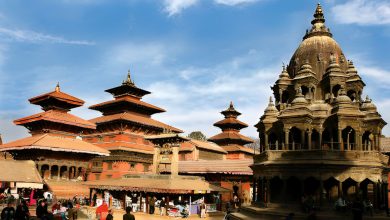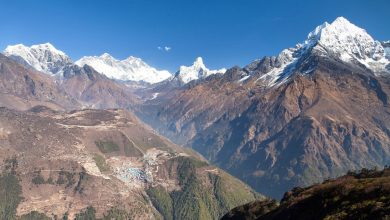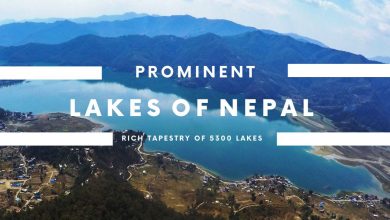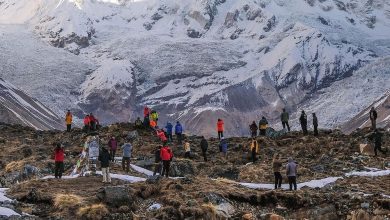How Hard Is It To Climb Mount Everest?
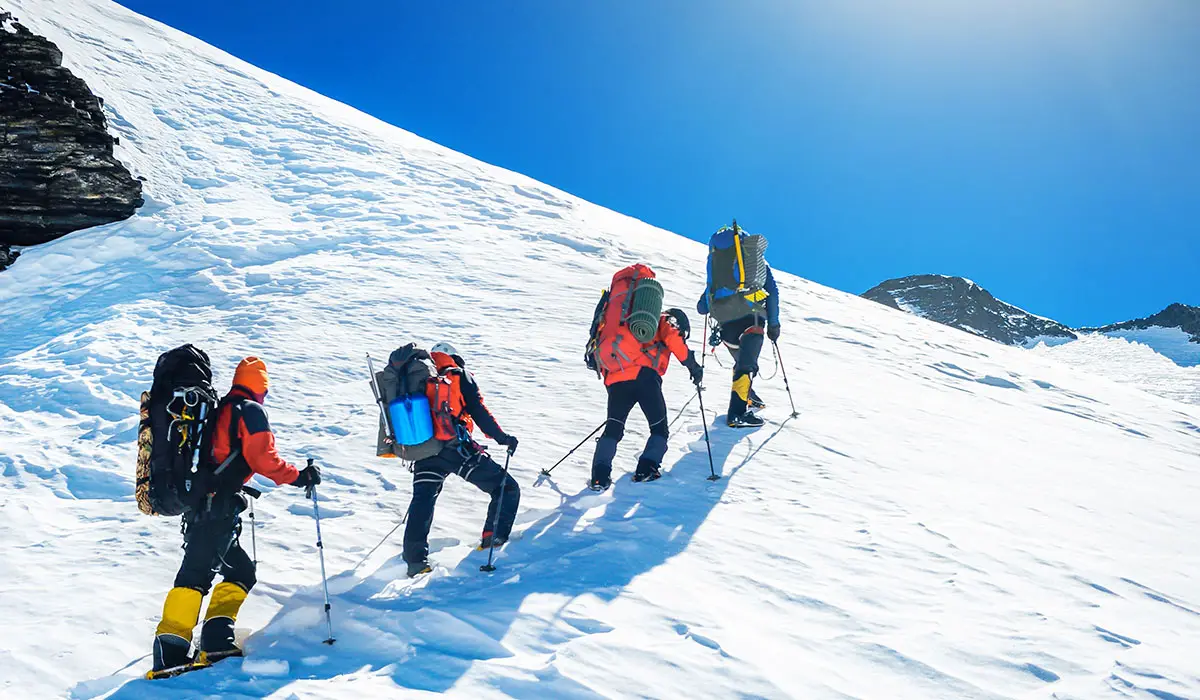
Mount Everest (8848.86 m) is a majestic mountain on the list of most avid mountain climbers. The tallest peak in the world provides climbers with an incredible adventure. One of the most challenging factors of this expedition is its epic elevation and terrain. Other reasons make this peak extremely difficult as well.
Everest Base Camp (5,100 m) is where climbers set up tents and begin their ascent. Before going on to climb this spectacular peak, extensive training is essential. The training regime should include strength and endurance, physical and mental preparation. Climbers should also learn about the use of mountaineering equipment like crampons, fixed ropes, jumar, carabiners, belay devices, ascenders, and others.
The summit ridge ascent is short and accessible, but there are several challenging sections in Mt. Everest, including Khumbu icefall. This dreaded section is also known as the “suicide passage,” where many mountaineers have perished. Besides, steep incline and glacial paths can be pretty tricky even for the most experienced climbers.
Moreover, altitude sickness is quite common in this high-altitude region with minimal air pressure and oxygen. The Himalayas are not inhabitable for humans. Therefore, climbers need to adapt and acclimatize to these conditions with an extended stay in the mountain. Overall, climbing Mount Everest is a high-risk climb that requires proper training and preparation.
Read on to know about how hard is it to climb Everest and other information in detail.
What Makes Mount Everest Expedition Difficult?
Long duration
Mt. Everest expedition is one of the most extended mountain expeditions globally. It has a training and preparation time of around 60 days. There are many challenges that climbers must endure during this journey, including cold weather, freezing temperature, and challenging terrains.
Besides that, climbers also need to acclimatize for a long time as it helps them adapt to high altitude conditions. This process will eventually help you to arrive at the summit successfully. March is the beginning of peak season in Everest as many climbers flock to Lukla on a scenic mountain flight. The trail then passes through Phakding, Jorsale, Monjo, Namche, Tengboche, Lobuche, Dingboche, and Gorakshep before reaching the base of Mount Everest.
You will be trekking on rugged terrain before arriving at the base camp. Professional guides and porters will help you to traverse and navigate challenging terrains. Therefore, the Everest Base Camp trek is essential before this Mount Everest expedition. Everest Base Camp (5,300 meters) is also the starting point of this expedition.
The shifting ice maze will challenge all climbers. Ascending and descending at different camps in high altitude regions is a must to acclimatize. After arriving at base camp, we will acclimatize before climbing camp 1. These climbers will stay at base camp for 4 to 5 days and then arrive at the Khumbu glacier.
Climbers will acclimatize at camp 1 for a couple of nights before descending back to the base camp. Once again, the expedition journey leads us to camp one, camp 2, and the base camp. The process of continuous ascending, descending, and acclimatizing is essential. The “Death Zone” above 8,000m is quite challenging, and hence it requires a long duration to complete this expedition.
You might also like: How Long Does It Take To Climb Mount Ama Dablam?
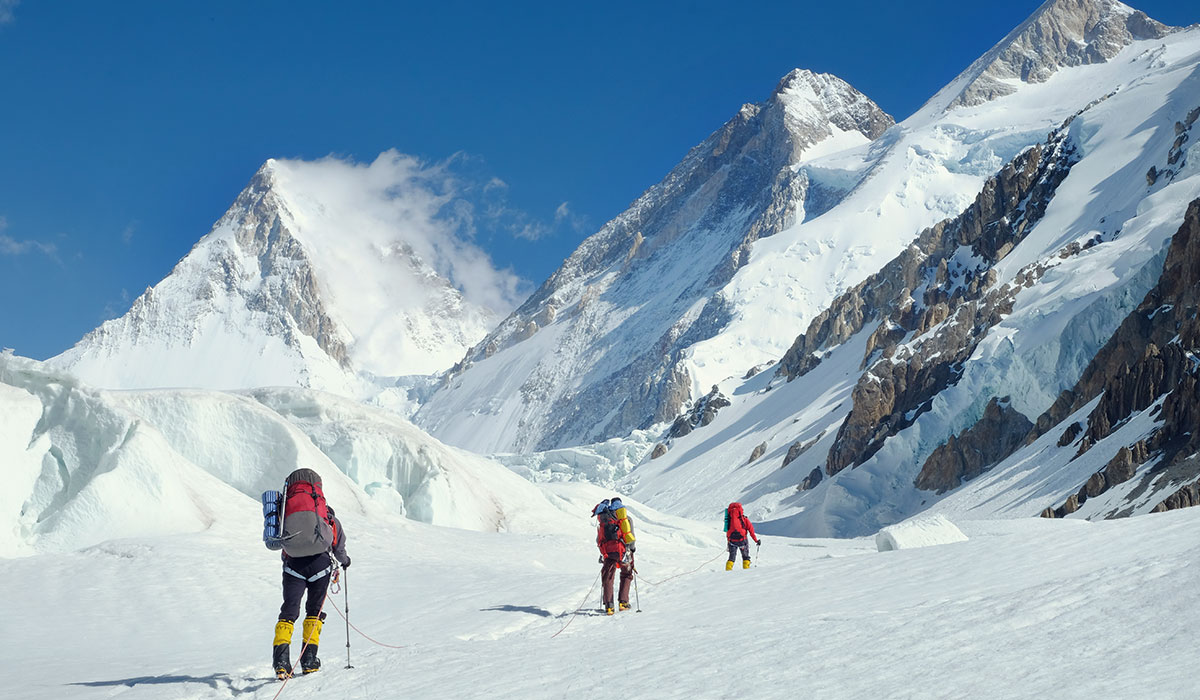
Acute Mountain Sickness
Mount Everest is a towering mountain with an elevation of 8848.86m above sea level. This is the highest mountain peak in the world. The Everest base treks have an increase of 600-800 meters in elevation per day. There is minimal oxygen and air pressure in this high altitude region, leading to Acute Mountain Sickness.
Altitude sickness is a significant difficulty in this Everest expedition. The Death Zone above 8,000m requires additional oxygen. Therefore, the climbers carry supplementary oxygen during this climb. Acclimatization is another essential part of this expedition. This process helps climbers to adapt to high altitude conditions and complete their climb of Mt Everest.
Trekkers and climbers should walk gradually at a gentle pace to tackle altitude sickness. Hydration at regular intervals becomes essential in these conditions. Therefore, proper acclimatization and preparation are a must for these mountain peak climbing adventures.
Avalanche
The Everest expedition has another difficult factor in the form of avalanches. There are various avalanche-prone areas in this expedition. The North Col and South Col are known as the avalanche-prone areas in the route to the Mount Everest expedition. Khumbu Ice Falls are also known as “Suicide Passage” as climbers need to cross this dangerous section to arrive at this summit.
You have to pass through these areas to arrive at the summit, but most trekkers try to reduce their time there. Climbers generally start their journey in the morning as the afternoon sun can warm and melt the snow. The Southeast route is prone to Falling ice and rocks, which can turn fatal for climbers.
Weather condition
The weather condition is another challenging factor as there are many weather-related challenges. There are many unpredictable snowstorms, snowfalls, and harsh winds in the area. Therefore, the weather forecast is essential as it will help you tackle many challenges and plan in advance.
Unpredictable weather also makes arriving and departing from Lukla a challenge. There are frequent delays or cancellations of flights in this small and dangerous airport. Travelers generally get stranded for many days in this airport due to bad weather.
The temperature in the Everest region generally decreases by 0.65 degrees Celsius as you gain 100 meters in altitude. Temperatures are on an average 57 degrees Celsius less than sea level at an altitude above 8000m. Mount Everest has extreme freezing temperatures while the sun heats upon the glistening surface of the mountain.
The daytime temperatures are cold, whereas nighttimes are even colder in the Everest region. The Everest base camp has a maximum temperature of 15 degrees C and average temperatures of around -12 degrees celsius with a wind speed of approximately 5 to 6 mph.
Read more on: Mount Everest Temperature
Improper Diet
Improper Diet is another factor that is quite challenging for trekkers and climbers in the expedition. Many climbers face this problem of food poisoning that leads them back to Kathmandu. Hence, a balanced diet and nutrition will help you immensely in your Mountain climbing experience.
The Everest Region does not have slaughtering practices due to ancient Buddhist beliefs. There is meat available, but they need to get transported to Lukla firstly by flight and then to various other settlements through yaks or porters. Proper refrigeration is not available in these settlements, which makes food poisoning quite common. Thus, it is best to avoid meat and meat products in these settlements along the trail.
The “Dal Bhat“ gets served twice a day along the trail, which is ideal for providing you with enough nutrition. Moreover, it contains ingredients like rice, lentils, dal (pulses), spinach, gundruk, vegetables, and pickles. This nutritious meal will be enough for you to provide the energy required for this expedition. Water purification tablets and solutions will provide you with clean and safe drinking water along trails.
You should also carry snacks during the trek, including protein bars, chocolate bars, snickers, and others to munch on during this trek. They will provide you with proper nutrients and satisfy your hunger during this Mount Everest expedition journey.
Falls
Mount Everest has many areas where climbers have a high risk of falling into snow gorges. It is a common factor of death on the Everest expedition. There are high ridges and other higher camps during this journey. The climbing expedition generally starts early in the morning in the dark, which is a risk factor. Footwork, knot checking, and other skills keep climbers safe during this Mount Everest expedition. Besides that, climbers must have good experience in high altitude climbing as well.
Crevasses
Crevasses can be pretty dangerous as they can appear in glacial ice and swallow climbers. The infamous Khumbu IceFall has turned out to be quite fatal for previous expeditions. To remain safe from these crevasses, climbers need to tie ropes with other climbers. This will allow them to drag them back to the top in case of emergencies.
Summit Fever
The Summit Fever is the temptation to push yourself beyond your limits as the summit is near. But this temptation can be quite dangerous and can turn fatal on the difficult slopes of Mount Everest. The mountaineers can set a “turnaround time” to allow themselves time to stop and not cross their limit.
A real-time setting will allow them to return if necessary and not overstay in the mountains, even if you are pretty close to the summit. Motivations can sometimes be toxic and work against your favor. Therefore, you need to care about these factors in the mountains.
If you consider all these factors on your Everest expedition, you will have a less challenging experience. Do not get carried away and keep yourself away from risking your life in the mountains. Trained professional climbers and Sherpa guides will help you to manage these conditions at Mount Everest summit.
Lack of Training
The Mt Everest expedition requires extensive training with proper mountaineering gear and equipment. This incredible Everest Base camp trek before this expedition also makes it quite challenging. Hire a personal trainer for strength and endurance exercises and also perform mountaineering skill training.
You can focus on strength and stamina-building exercises at least six months before your journey. Hiking, Jogging, swimming, cycling, and other cardiovascular activities will help you gain flexibility and improve your breathing capability in high altitude regions. Lightweights will help you build muscular strength in your arms, shoulder, and thighs.
Hence, these are various difficulty parameters that make the Everest expedition difficult. These factors provide you information on how difficult is it to climb Mount Everest.
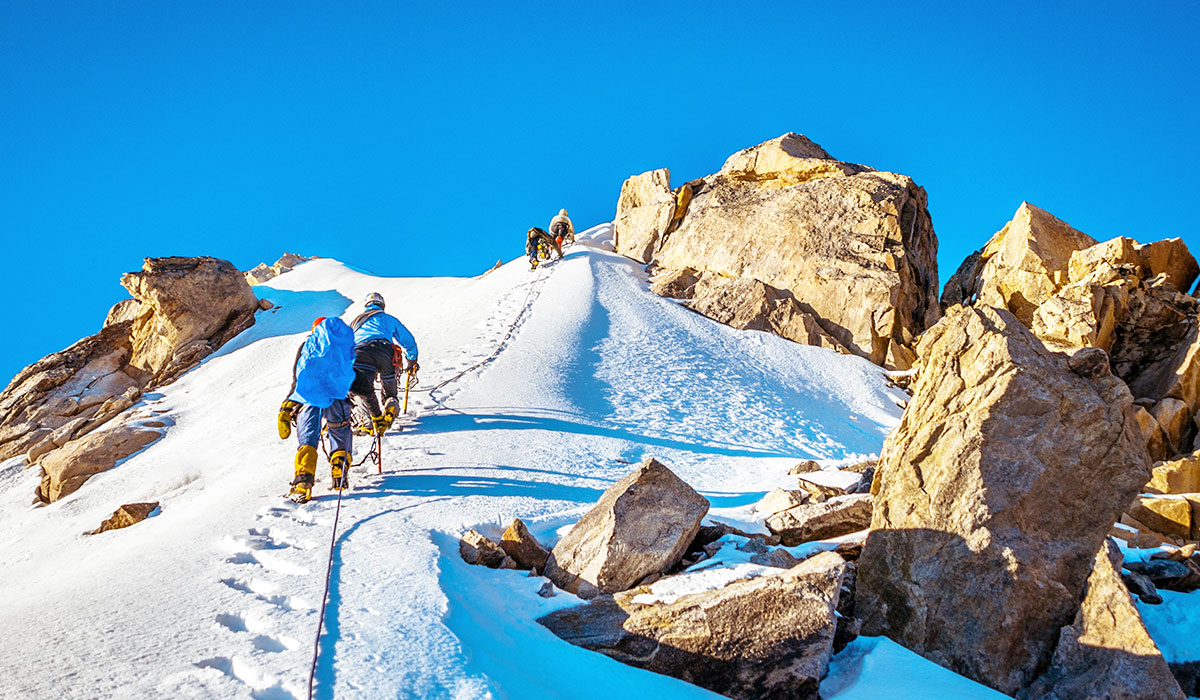
How Hard Is It To Climb Everest? – The Climbing Routes
Everest Base Camp is the point of our Mt. Everest expedition, as our Sherpa guides will help you set up tents and camps around the region. High altitude camping and acclimatization are essential to tackle acute mountain sickness along the journey. The south side route from Nepal is a challenging adventure as it passes through the Khumbu icefall and Glacier.
Once you cross the Khumbu icefall, The South route is less technically challenging. Climbers need to tackle various crevasses and seracs using fixed ropes and ladders, and there are ice cliffs around camp 3. Khumbu Icefall also includes extensive falling ice, which needs proper consideration. This Khumbu icefall crossing is only possible when the Sherpa crew install ladders, set the route, and crevasses and ice walls.
Summit Attempt from South Side
Mount Everest’s south side is also known as the Nepalese side. The southern side is more challenging and adventurous than the North and hence is quite popular among climbers. This expedition journey from the south side includes various acclimatization, camping, and summit climb.
Various Camps along the Route
Camp 1 (6000m) is a resting camp where we will transition to Camp 2 (6400m). There are crevasses in camp 1, and therefore, you should generally have ladders for safety. Camp 2 lies at the west ridge bottom and provides majestic views of Lhotse and other snow-capped mountains. Most kitchen and dining areas are located in a lateral moraine. It is the base for camp three and is generally used for acclimatization.
Camp 3 (7200m) remains located on the Lhotse wall. The Glacier allows you to climb 40 deg. 600m to arrive at Camp 3 through a snowfield. There are fixed ropes along 3m ice cliffs around camp 3. Camp 4 (7950m) is accessible without supplementary oxygen.
South Col to Balcony:
Camp 4 in South Col leads you to the summit, which is around 500m. There are various weather-related challenges with Gayle force winds which can cause multiple challenges in the expedition. The narrow South-East Ridge along the summit climb route can be pretty dangerous.
The south col to Balcony journey takes around 4 hours. You will take a half-an-hour break on this journey at the Balcony. After the break, you will climb the south summit for approximately two and a half hours from the Balcony. After another half-hour break at South Col, we will relax and observe the Himalayas.
At this beautiful camp of the south col, we will take a long rest break and acclimatize. Climbers take around eighteen hours in a minimum to reach the summit. Extra oxygen supplements and other preparations are essential if you decide to stay at the South Col.
It can turn quite challenging and even fatal if you try to stay at a high altitude without supplemental oxygen. The high-altitude freezing conditions with less air pressure and oxygen will not allow our body to function correctly. After climbing the summit, we will observe the beautiful Himalayan region and descend back through the Hilary step.
We will descend to the Balcony from Hilary’s step for around two hours. From Balcony, we will drop back to South Col, which takes around an hour. We will spend the night at South Col or camp 2. At camp 2, you do not require supplemental oxygen. We will return from camp 2 to camp one and then to base camp. Hence, these climbing routes also determine how hard is it to climb Mount Everest.
Training Routine For Mount Everest
Mount Everest is a challenging mountain. Climbers must have the proper physical and mental strength to conquer this incredible mountain. Strength and endurance, with intense cardiovascular conditioning and high-altitude climbing experience, become essential to summit the tallest mountain peak in the world. Read on to know more about the complete training regime required for this Everest expedition:
Physical Strength and endurance training
Physical Strength and endurance training is a must to arrive at the top of Mount Everest. Physical conditioning in high altitude conditions with a practice of carrying around 50–60 lbs. You need to condition your body to high tolerance so that it builds extra reserves. You will require this when you lose body fat and musculature due to extended stays at high altitude conditions. This physical preparation will ensure a safe and injury-free expedition.
Technical Training
The technical training of this expedition includes physical conditioning above 20,000 ft. Climbers also have to deal with mountaineering gear and equipment, including carabiners, fixed ropes, belay devices, ascenders, crampons, jumar, and others.
A proper skill of crampons on snow, rock, and ice will help you tackle the summit. Besides that, you should also learn how to use jumars, ascenders, fixed-line, and rappel with a pack. Alpine living, ice-climbing skills, and others are a significant part of high altitude climbing expeditions. Tackling cold temperatures is an integral part of this expedition.
Cardiovascular training
Cardiovascular training is an essential part of the training regime for this Mount Everest expedition. Jogging, swimming, cycling, hiking, and other activities fall under this training routine. Pack-loaded hiking, stair climbing, and pace walking will also help you to tackle various challenges in this expedition. These activities will help you expand your lungs and allow you to breathe at high altitudes with ease.
Mental Preparation
Mental preparation along with physical practice is essential for this expedition. All climbers need to have proper mental health and a positive attitude to summit Everest successfully. A positive and prepared mind will help you overcome all of the difficulties of this challenging expedition in the Himalayas. A good team leader and professional Sherpa guide will also motivate you along the journey.
Flexibility training
Training well before this expedition will help you remain flexible as flexibility keeps you injury-free in rugged terrains. You should prepare six months before this expedition. A solid fitness level maintenance in the last six months is a plus point for all climbers.
Hiking distance, duration, and elevation should be gradually increased while training. It will help you build fitness and gain climbing-specific conditioning. However, it would help if you did not rush through or complete training in a hurry as it increases the injury risk.
How to Overcome Difficulties? Tips for Everest Expedition
We now know how hard is it to climb Everest and what factors make Mt. Everest expedition difficult. Therefore, we can perform specific steps to reduce them significantly. Some of the valuable tips to overcome these difficulties are as follows:
Prepare at least six months prior.
It would help if you prepared well before this incredible expedition at least six months before the ascent. The trip requires muscular strength and endurance level. Physical training must start before at least six months as it will help you transform your body to have a climber’s body. You should also perform a hike, gym, running, swimming, and others for six months along with physical training.
Select a good expedition and travel company
A proper expedition and travel company is a must for a safe Mount Everest expedition. Such expedition operators will have appropriate facilities and experienced employees that will take care of your needs. Besides that, you will also get the best Sherpa guides, porters, team leaders, and other staff. Therefore, a skilled and experienced expedition team is essential for this Everest expedition.
Gain some experience in high altitude climbing
Mountaineers must have experience in high altitude mountain climbing. This will help you adapt to high altitude conditions, and you will gain experience in such situations. Therefore, travelers must gain some high-altitude climbing experience.
Pick the peak climbing season.
The climbing season of Everest is generally March to May in the Spring season. Not all times are suitable for this expedition as there are many harsh weather conditions, especially in Winter and Monsoon seasons. Therefore, ensure that you pick the perfect season for your mountain climbing adventure.
Get proper climbing gear and equipment.
The proper gear and equipment are essential for this expedition to the highest mountain peak in the world. Your backpack must have all the lists mentioned by your team leader.
Train well before the expedition
The Everest expedition is only possible with rigorous training. This training regime should also contain the use of various mountaineering gear and equipment. Besides that, you should also have mental preparation to complete this incredible expedition with ease.
Ensure proper hygiene during this trip
Everest expedition is a long-duration journey that takes almost 60 days to complete. Therefore, travelers need to have proper personal hygiene and health. There are many hygiene-related illnesses like diarrhea, along trails which makes this expedition quite challenging. The meat products need to get avoided as they are not fresh due to lack of refrigeration.
Don’t shorten your stay.
A successful summit climb of Mount Everest requires proper packing preparation and acclimatization. And therefore, you should acclimatize adequately for many days before making a summit climb. You will have high chances of getting altitude sickness or acute mountain sickness. Hence, a long itinerary will allow you to trek and successfully climb the mountain with less risk.
Hence, these were things that determine how hard is it to climb Mount Everest. Climbers need to get considered during this Everest expedition.
You may also like:
- Gokyo Renjo La Pass Trek 12 Days
- Rainbow Valley Everest
- How Cold Is It On Mount Everest?
- Closest Airport to Mount Everest
Final Say
Mount Everest expedition is on the list of many avid mountaineers. However, this incredible challenge requires climbers to have outstanding stamina and fitness. Climbers also need to complete high-altitude trekking adventures before this expedition. A proper training regime becomes essential to reduce the difficulty of this expedition.
Moreover, there are various weather-related and other challenges that determine how difficult is it to climb Mount Everest. So, proper acclimatization and rest are a must to adapt to high altitude weather and climatic conditions. The mountaineers must consider all the challenges of this expedition.
We hope you learned about how hard is it to climb Everest through this article. Contact us for detailed information about this incredible expedition. Have a safe journey!
